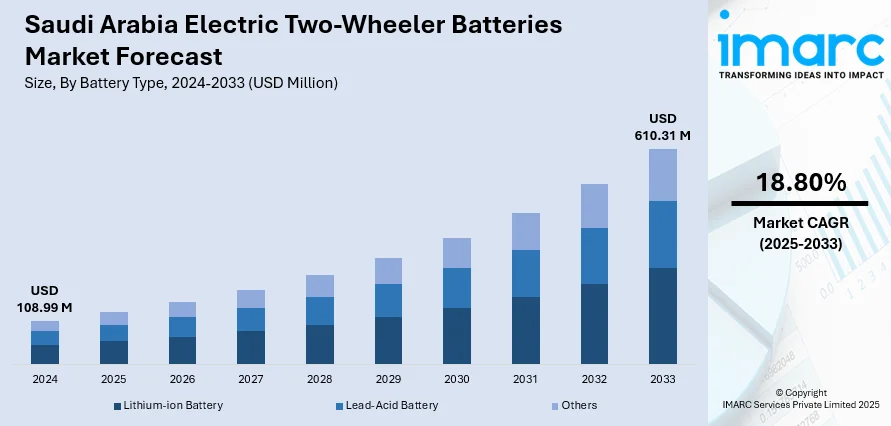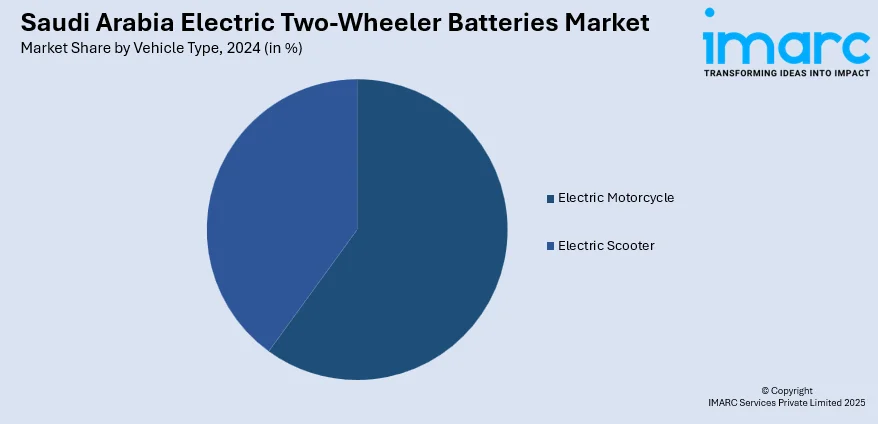
Saudi Arabia Electric Two-Wheeler Batteries Market Size, Share, Trends and Forecast by Battery Type, Vehicle Type, and Region, 2025-2033
Saudi Arabia Electric Two-Wheeler Batteries Market Overview:
The Saudi Arabia electric two-wheeler batteries market size reached USD 108.99 Million in 2024. Looking forward, IMARC Group expects the market to reach USD 610.31 Million by 2033, exhibiting a growth rate (CAGR) of 18.80% during 2025-2033. The market is influenced by trends like the government's Vision 2030 policy advocating for environmentally friendly transport, urbanization causing traffic congestion, and battery technology improvements boosting the performance and costs of the vehicles. All these factors together work to help drive the Saudi Arabia electric two-wheeler market share.
|
Report Attribute
|
Key Statistics
|
|---|---|
|
Base Year
|
2024
|
|
Forecast Years
|
2025-2033
|
|
Historical Years
|
2019-2024
|
| Market Size in 2024 | USD 108.99 Million |
| Market Forecast in 2033 | USD 610.31 Million |
| Market Growth Rate 2025-2033 | 18.80% |
Saudi Arabia Electric Two-Wheeler Batteries Market Trends:
Government Initiatives and Policy Support
The Saudi Arabian government has implemented various policies to promote the adoption of electric two-wheelers, aligning with its Vision 2030 goals of reducing carbon emissions and diversifying the economy. These initiatives include tax exemptions, subsidies for charging infrastructure, and lower registration fees, making electric two-wheelers more accessible to consumers. For instance, as of 2024, Saudi Arabia is expanding its charging infrastructure. The Electric Vehicle Infrastructure Company (EVIQ), a joint venture between PIF and the Saudi Electricity Company, plans to install over 5,000 fast chargers across more than 1,000 locations by 2030. These initiatives reflect Saudi Arabia's commitment to reducing emissions and fostering a sustainable, diversified economy.

Urbanization and Demand for Efficient Mobility
With nearly more than half of Saudi Arabia's population residing in urban areas, cities like Riyadh and Jeddah face significant traffic congestion. Electric two-wheelers offer a practical solution for short-distance commuting, providing a convenient and eco-friendly alternative to traditional vehicles. The increasing demand for efficient mobility solutions in densely populated areas is driving the adoption of electric two-wheelers, contributing to the market's growth. For instance, in February 2025, NAVEE launched its electric scooters, ST3 Pro, GT3 Pro, and V25i Pro, in Saudi Arabia, aligning with the nation's Vision 2030 initiative promoting sustainable mobility. The ST3 Pro features a 1350W rear-drive motor, quadruple suspension, and a 75 km range. These models are TÜV Rheinland certified and come with safety features like traction control and triple braking systems.
Technological Advancements and Affordability
Advancements in battery technology, particularly in lithium-ion batteries, have led to improvements in energy density, charging efficiency, and battery lifespan. These technological developments have reduced the overall costs of electric two-wheelers, making them more affordable for consumers. The decreasing cost of battery components, along with the introduction of new models designed for the Saudi market, is enhancing the accessibility and appeal of electric two-wheelers, thereby driving market growth. For instance, in May 2024, TVS Motor Company introduced a new variant of the iQube electric scooter featuring a 2.2 kWh battery. This model offers a top speed of 75 km/h, a 950W charger with a 0–80% charging time of two hours, and a 30-litre under-seat storage. It also includes a 5-inch colour TFT screen with navigation and alerts. Additionally, the iQube ST variants with 3.4 kWh and 5.1 kWh batteries are now available for nationwide delivery, offering ranges of 100 km and 150 km respectively, along with advanced features like voice assist and a 7-inch TFT display.
Saudi Arabia Electric Two-Wheeler Batteries Market Segmentation:
IMARC Group provides an analysis of the key trends in each segment of the market, along with forecast at the country/regional level for 2025-2033. Our report has categorized the market based on battery type and vehicle type.
Battery Type Insights:
- Lithium-ion Battery
- Lead-Acid Battery
- Others
The report has provided a detailed breakup and analysis of the market based on the battery type. This includes lithium-ion battery, lead-acid battery, and others.
Vehicle Type Insights:

- Electric Motorcycle
- Electric Scooter
A detailed breakup and analysis of the market based on the vehicle type have also been provided in the report. This includes electric motorcycle and electric scooter.
Regional Insights:
- Northern and Central Region
- Western Region
- Eastern Region
- Southern Region
The report has also provided a comprehensive analysis of all the major regional markets, which include Northern and Central Region, Western Region, Eastern Region, and Southern Region.
Competitive Landscape:
The market research report has also provided a comprehensive analysis of the competitive landscape. Competitive analysis such as market structure, key player positioning, top winning strategies, competitive dashboard, and company evaluation quadrant has been covered in the report. Also, detailed profiles of all major companies have been provided.
Saudi Arabia Electric Two-Wheeler Batteries Market News:
- In April 2025, Saudi Aramco partnered with BYD to develop battery and plug-in hybrid technologies, marking a strategic push into the electric vehicle sector. This alliance supports Aramco’s diversification and follows its earlier plans to enter the lithium battery materials market. The collaboration will integrate R&D efforts to drive advancements in New Energy Vehicle efficiency and sustainability. With Saudi EV adoption still low, Aramco’s battery-focused ventures aim to accelerate electric mobility aligned with national climate goals and future energy transitions.
Saudi Arabia Electric Two-Wheeler Batteries Market Report Coverage:
| Report Features | Details |
|---|---|
| Base Year of the Analysis | 2024 |
| Historical Period | 2019-2024 |
| Forecast Period | 2025-2033 |
| Units | Million USD |
| Scope of the Report |
Exploration of Historical Trends and Market Outlook, Industry Catalysts and Challenges, Segment-Wise Historical and Future Market Assessment:
|
| Batteries Types Covered | Lithium-ion Battery, Lead-Acid Battery, Others |
| Vehicles Types Covered | Electric Motorcycle, Electric Scooter |
| Regions Covered | Northern and Central Region,Western Region, Eastern Region, Southern Region |
| Customization Scope | 10% Free Customization |
| Post-Sale Analyst Support | 10-12 Weeks |
| Delivery Format | PDF and Excel through Email (We can also provide the editable version of the report in PPT/Word format on special request) |
Key Questions Answered in This Report:
- How has the Saudi Arabia electric two-wheeler batteries market performed so far and how will it perform in the coming years?
- What is the breakup of the Saudi Arabia electric two-wheeler batteries market on the basis of battery type?
- What is the breakup of the Saudi Arabia electric two-wheeler batteries market on the basis of vehicle type?
- What is the breakup of the Saudi Arabia electric two-wheeler batteries market on the basis of region?
- What are the various stages in the value chain of the Saudi Arabia electric two-wheeler batteries market?
- What are the key driving factors and challenges in the Saudi Arabia electric two-wheeler batteries?
- What is the structure of the Saudi Arabia electric two-wheeler batteries market and who are the key players?
- What is the degree of competition in the Saudi Arabia electric two-wheeler batteries market?
Key Benefits for Stakeholders:
- IMARC’s industry report offers a comprehensive quantitative analysis of various market segments, historical and current market trends, market forecasts, and dynamics of the Saudi Arabia electric two-wheeler batteries market from 2019-2033.
- The research report provides the latest information on the market drivers, challenges, and opportunities in the Saudi Arabia electric two-wheeler batteries market.
- Porter's five forces analysis assist stakeholders in assessing the impact of new entrants, competitive rivalry, supplier power, buyer power, and the threat of substitution. It helps stakeholders to analyze the level of competition within the Saudi Arabia electric two-wheeler batteries industry and its attractiveness.
- Competitive landscape allows stakeholders to understand their competitive environment and provides an insight into the current positions of key players in the market.
Need more help?
- Speak to our experienced analysts for insights on the current market scenarios.
- Include additional segments and countries to customize the report as per your requirement.
- Gain an unparalleled competitive advantage in your domain by understanding how to utilize the report and positively impacting your operations and revenue.
- For further assistance, please connect with our analysts.
 Request Customization
Request Customization
 Speak to an Analyst
Speak to an Analyst
 Request Brochure
Request Brochure
 Inquire Before Buying
Inquire Before Buying




.webp)




.webp)












